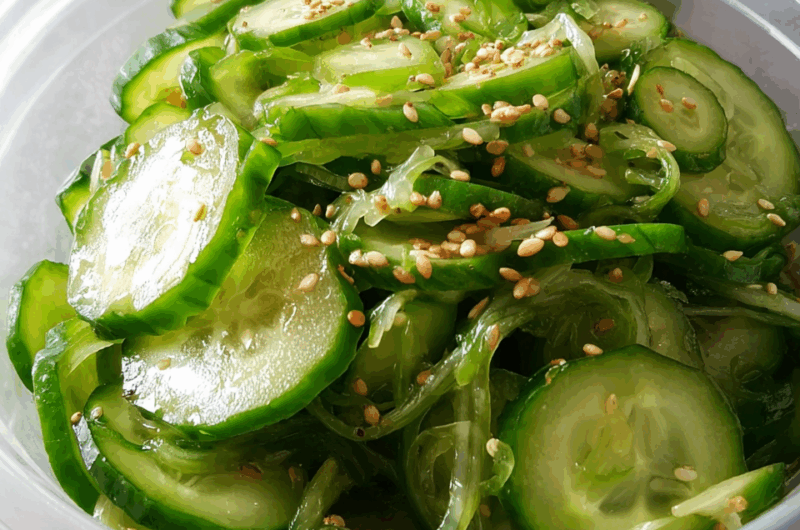This Japanese cucumber salad, known as Sunomono, is a delightful combination of sweet, tangy, and savory. With its simple ingredients and bright flavors, it’s a staple in Japanese households and sushi restaurants alike. The cucumbers are salted and softened before being dressed in a refreshing mixture of lemon juice, sugar, and vinegar, creating a dish that’s as vibrant as it is refreshing.
Topped with toasted sesame seeds, this salad offers just the right amount of crunch and nuttiness. Sunomono is perfect on its own as a light snack or as a complement to grilled meats and seafood. It’s quick to prepare and stores well in the fridge, making it a wonderful make-ahead dish for meal prep or gatherings.
Full Recipe:
-
5 cucumbers
-
2 teaspoons salt
-
½ cup lemon juice
-
½ cup white sugar
-
1 tablespoon white wine vinegar
-
¼ cup toasted sesame seeds, or to taste
Directions:
-
Partially peel the cucumbers lengthwise, leaving thin green stripes for presentation. Cut each cucumber in half lengthwise.
-
Scoop out the seeds with a spoon and discard them. Thinly slice the cucumbers and place them into a large bowl.
-
Add salt to the sliced cucumbers and massage with your hands until the cucumbers become limp. Let them sit for 45 minutes.
-
Transfer the cucumbers to a strainer and squeeze out as much liquid as possible.
-
In a large bowl, whisk together lemon juice, white sugar, and white wine vinegar until the sugar is fully dissolved.
-
Add the drained cucumbers and toss until well coated.
-
Portion into small serving bowls and sprinkle with toasted sesame seeds before serving.
Prep Time: 15 minutes | Rest Time: 45 minutes | Total Time: 1 hour
Kcal: 93 kcal | Servings: 8 servings
What is Japanese Cucumber Salad (Sunomono)?
Japanese Cucumber Salad, known as Sunomono (酢の物) in Japanese, is a light, refreshing, and tangy side dish made primarily from thinly sliced cucumbers, seasoned with vinegar and sugar. The name Sunomono literally means “vinegared things,” with “su” referring to vinegar and “mono” meaning things. It is one of the most common and beloved dishes served in Japanese households, izakayas (Japanese pubs), and sushi restaurants alike.
While it may appear simple, this salad is packed with flavor, offering a perfect balance of sweetness, acidity, and a subtle crunch from the cucumbers. Sunomono serves as a palate cleanser and is often enjoyed alongside rich dishes such as grilled fish, tempura, or fatty sushi, making it both a healthful and functional component of a traditional Japanese meal.
Cultural Significance in Japanese Cuisine
In traditional Japanese cooking, balance and presentation are essential. Dishes are constructed to include a variety of flavors, textures, and colors. A typical Japanese meal includes rice, a main protein, a soup (like miso), and small vegetable-based side dishes, often pickled or lightly seasoned.
Sunomono is one of those side dishes that complements heavier flavors and adds a refreshing acidity to the meal. It is especially popular during warmer months due to its cooling and hydrating properties. Its minimal preparation, reliance on fresh ingredients, and emphasis on balance reflect the principles of washoku — the traditional dietary culture of Japan that was designated a UNESCO Intangible Cultural Heritage in 2013.
The Role of Vinegar in Japanese Cooking
Vinegar plays a central role in Japanese cuisine beyond just Sunomono. It’s used in a variety of ways — from seasoning sushi rice to pickling vegetables and enhancing dipping sauces. In Sunomono, vinegar’s sharpness is mellowed with sugar and sometimes a touch of salt, creating a complex but gentle flavor profile that enhances rather than overwhelms the dish.
While rice vinegar is traditionally used in most Sunomono preparations, many home cooks and modern variations use white wine vinegar or lemon juice for a citrusy twist. This adaptability keeps the dish timeless yet innovative.
Health Benefits of Sunomono
Sunomono is not only delicious but also offers several health benefits:
-
Low in Calories: A typical serving of Japanese cucumber salad contains under 100 calories, making it a guilt-free addition to any meal.
-
Hydrating: Cucumbers are composed of over 95% water, which helps with hydration and digestion, especially in hot weather.
-
Digestive Aid: The vinegar in the dressing can aid in digestion and support gut health due to its mild antimicrobial properties.
-
Rich in Antioxidants: Cucumbers contain compounds like flavonoids and tannins that may help reduce inflammation and protect cells from oxidative damage.
-
Low in Fat and Sugar: Even with the added sugar in the dressing, the overall sugar content remains modest, and the fat is nearly negligible unless sesame oil is added.
-
Diet-Friendly: This salad is suitable for many dietary needs — vegan, gluten-free, dairy-free, and paleo (if sugar is substituted).
To Peel or Not to Peel: The Cucumber Debate
Traditionally, Japanese cucumbers are used in Sunomono due to their thin skin, mild flavor, and minimal seeds. They are typically sliced very thin — often with a mandoline slicer — to enhance texture and appearance. When using thicker-skinned Western cucumbers, it’s common to partially peel them, leaving alternating green stripes for visual appeal and to reduce bitterness.
Some modern recipes skip the de-seeding and peeling steps, especially when using English cucumbers or Persian varieties, which are more tender and have fewer seeds.
Variations and Modern Twists
Though the classic version of Sunomono involves cucumbers, vinegar, and sesame seeds, there are numerous regional and modern variations:
-
Seafood Sunomono: Add cooked shrimp, crab meat, or octopus (tako) to make the dish heartier. This is a common version served as an appetizer at sushi restaurants.
-
Wakame (Seaweed) Sunomono: Adding rehydrated wakame seaweed enhances the umami and adds minerals like iodine and calcium.
-
Daikon Sunomono: Thinly sliced daikon radish adds crunch and peppery notes to the traditional cucumber base.
-
Fruit-Infused Sunomono: Some versions include sliced strawberries or oranges, adding a creative and sweet twist.
-
Spicy Sunomono: A dash of chili oil or sliced red chili can add heat for those who prefer a little kick.
These variations not only broaden the dish’s appeal but also allow for seasonality and creativity, depending on what ingredients are available.
Pairing Suggestions
Sunomono is incredibly versatile and can be served with:
-
Grilled fish or teriyaki salmon – Its acidity cuts through the richness of oily fish.
-
Tempura – The lightness of Sunomono contrasts beautifully with deep-fried tempura.
-
Sushi and sashimi – Its refreshing nature complements raw fish and vinegared rice.
-
Bento boxes – Sunomono is a popular inclusion in homemade and store-bought bentos for both aesthetic and functional reasons.
-
BBQ and grilled meats – Outside of Japanese cuisine, it works well as a fresh side dish to balance heavier meats and sauces.
Make-Ahead and Storage Tips
Sunomono is one of those rare dishes that actually improves in flavor after sitting for a few hours. The cucumbers absorb more of the tangy-sweet dressing, and the overall dish becomes more cohesive. However, it’s important not to let it sit for more than 2–3 days as the cucumbers may lose their texture and become overly soggy.
If you plan to prepare it ahead of time:
-
Store in an airtight container in the refrigerator.
-
Add sesame seeds and any garnishes just before serving to maintain crunch.
-
For best results, slightly under-salt the cucumbers if storing for a long time, as the salt continues to draw moisture over time.
A Visual and Sensory Experience
Beyond its taste, Sunomono is visually appealing. The thin, almost translucent cucumber slices, glistening with the light dressing and topped with toasted sesame seeds, provide a clean and minimalist aesthetic that aligns with Japanese plating principles.
When garnished thoughtfully — with shiso leaves, edible flowers, or a sprinkle of yuzu zest — it transforms from a simple salad into a work of edible art. It’s an ideal dish for food bloggers and home entertainers alike.
Why You Should Add Sunomono to Your Recipe Collection
Whether you’re a seasoned home cook or just starting to explore Japanese cuisine, Sunomono is a must-try recipe. It uses pantry-friendly ingredients, requires minimal cooking skills, and can be adapted to suit any dietary need or flavor preference. Its versatility, health benefits, and aesthetic appeal make it more than just a salad — it’s a symbol of culinary balance and thoughtful eating.
By mastering this humble dish, you also gain insight into Japanese food philosophy: one that values simplicity, seasonality, and harmony between ingredients.
Conclusion
Japanese Cucumber Salad (Sunomono) may seem like a simple side dish, but it offers a profound insight into the beauty of Japanese cuisine. With just a few basic ingredients, it delivers a burst of flavor, refreshment, and nutrition. Its adaptability means you can enjoy it with various meals, across seasons, and tailored to your own taste.
Whether you’re hosting a dinner party, meal prepping for the week, or just craving something light and tangy, Sunomono is a recipe that deserves a permanent spot in your culinary repertoire. It’s a dish that exemplifies how elegance and depth can come from simplicity — and how sometimes, the most modest recipes are the most unforgettable.








